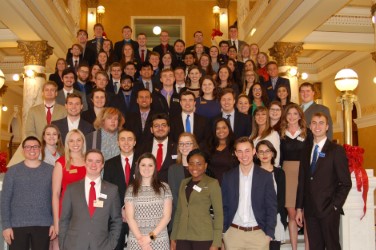
Student Federation works with SDBOR institutions, legislature
The Student Federation is a group of students from the South Dakota Board of Regents institutions who oversee numerous issues affecting students.
Issues discussed at Student Federation meetings range from legislation like Senate Bill 103 to campus issues such as the concealed carry debate. The group represents higher education in South Dakota, and they vote on issues affecting students at the SDBOR institutions.
Student Federation consists of two representatives from each of the six South Dakota institutions’ student government associations, totaling 12 voting members including a chair and a student executive director who take care of Student Federation duties.
Relevant issues
Senate Bill 103 and House Bill 1073 are issues that the Student Federation expressed concern about in recent meetings.
The Student Federation body members do not lobby for their institutions, however, the executive director acts on the behalf of the consensus reached by voting board members. If no decision is reached, board members can debate topics before they are brought to the SDBOR’s attention.
SGA Vice President Anderson said the issue of concealed carry was an example of an issue Student Federation board members debated in the past.
“When the concealed carry on campus was going through, there was a disagreement between some schools,” Anderson said. “Some were in support of it and others in opposition to it. That would be an example if we were split on the topic that the Student Federation would not act on behalf of us as a regental system.”
Taylin Albrecht, a senior human development and family studies double major and the Student Association (SA) president at SDSU, said learning about other university policies in Student Federation is a unique tool to collaborate with other SDBOR institutions.
“The Student Federation is a way to connect with the other regental universities.” Albrecht said. “We have those lines of communication open.”
Albrecht said one way their SA learned from USD through Student Federation was by implementing an alcohol diversion program. USD’s alcohol prevention program consists of three programs, e-CHUG, CHOICES and Prime for Life, which are aimed at treating those who are at a high risk for alcohol abuse.
The partnership that USD and SDSU share at the Student Federation is vital when it comes to issues affecting campus, like House Bill 1073, a bill to protect free speech on college campuses. The bill was ultimately deferred to the 41st legislative day.
“It really helps to have a strong relationship with (SGA president McNary and vice president Anderson). We took a stance on House Bill 1073 which (USD’s) SGA did as well,” she said. “The day we were going to potentially pass those resolutions to our bodies, we were communicating back and forth and trying to mirror some of the same language. Once we did pass those through, Teagan and I did give our testimony together in the committee meeting.”
Representation and teamwork
Anderson said the importance of Student Federation is the unity between each institution.
“It’s nice to be able to go to the legislature or the regents as one unified presence rather than six individual schools that may carry different weight,” Anderson said. “With different people, we can join our efforts and have a more productive and constructive conversation.”
Communication is something that legislators and regent members value with the Student Federation. Conrad Adam, senior finance major and student representative for the SDBOR, said he continues to keep open communication with McNary and Anderson.
“We have conversations about issues going on in our system, whether that’s proposed tuition increases, building project proposals or whatever it may be, we do visit often about certain issues going on,” Adam said.
Adam said each university’s equivalent of SGA has “a huge amount of pull” on their campuses and at the SDBOR level.
“The student perspective carries a lot of weight in this state, which is neat to see,” Adam said. “Not only is a student regent serving on the Board of Regents, but also the Student Federation has a huge say in what goes on our campuses.”
Looking forward
As McNary and Anderson near the end of their term, new executive officers will soon take their place to represent students at the Student Federation. Anderson and McNary will still serve until March when a new executive director is chosen. The executive director listens to student board members of the federation and from what the members vote, the executive director then tells the SDBOR about their decision.
Anderson said he’s looking forward to see what direction Student Federation will go.
“I’m excited to see how (Student Federation) moves forward,” Anderson said. “I’m excited to see who the new executive director will be and what direction they will take Student Federation. I think there’s still room to improve it, there’s untapped potential there, and it can be really used with the regents and the legislature moving forward.”


